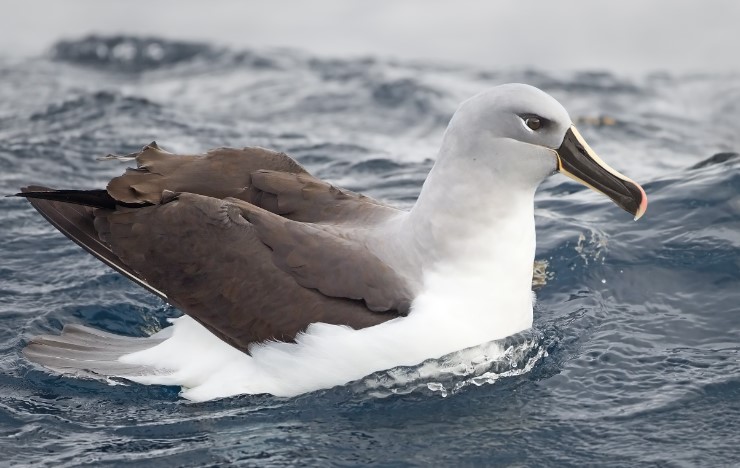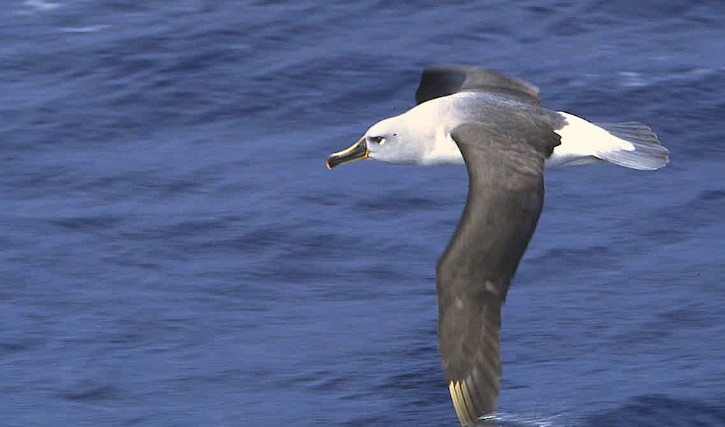Family: Grey-headed albatross (Thalassarche chrysostoma) is large seabirds from the albatross family Diomedeidae.
Name: Molymawks is named after the Dutch word mallemok, which literally means foolish gull, which is used to describe Grey-headed, Black-browed, and other small albatrosses. This name may have been given to them because they are easy to catch on hooks baited with meat or fish, or – when they are glutted with food and too sluggish to rise from a calm sea – they can be caught easily by a net or a spear. The other names are the Flat-billed Albatross, Grey-headed Mollymawk, and Gould’s Albatross.
Adaptation: It is more common to see Grey-headed Albatrosses alone than in groups in Australian waters, usually during the winter months. The bird follows ships and attends fishing boats, but not very closely. In spite of its long voyages at sea, it does not seem to wander as widely as the Black-browed Albatross, staying in the more southerly sub-Antarctic waters and often resting back on the nest mound on breeding islands.

Similar Species: The Grey-headed Albatross looks like Buller’s Albatross, a rare species that only wanders into the southeast coast of Australia from New Zealand seas. Although it lacks the white front of Buller’s Albatross, the Grey-headed Albatross has a black edge around its underwing that is almost as wide as that of the Black-browed Albatross.
Habitats: These albatrosses nest in colonies, often in association, although somewhat later than Black-browed Albatrosses. Young may not fledge until mid-May despite hatching in late December – they are fed both by their parents – a month behind Black-browed fledglings. The Grey-headed Albatross eats fish, squid, crustaceans, galley scraps, and carrion, including dead seabirds. It must land on water to catch them, and when it comes in, it lowers and spreads its huge webbed feet to break flight, just like other albatrosses do. Nesting occurs on Grey-headed Albatross breeding islands in September. While courting, birds hold their bills motionless, touching each other’s sides. A male and female then parade around one another while bowing, braying, flapping, tilting their tails, and preening one another.
Grey-headed Albatross Speed: Their enormous wingspan of 2.2m enables them to fly at speeds of 127km per hour and circumnavigate the world in under a month. Grey-headed albatrosses return to land to breed despite spending most of their lives at sea.
Size: The size of the Grey-headed Albatross is about 910 mm in lengths along with wingspan up to 2150 mm. With a mean mass of 3.65 kg (8.0 lb), weight can range from 2.8 to 4.4 kg (6.2 to 9.7 lb).

Adults: The male and female are similar; the female is smaller. The head and nape are grey; the back is black and warm. Upper wings are black; underwings are white with black edges, broader on the leading edge; tails are grey. Grey is the color of the throat. While lying on the breasts and belly. There is a crescent behind the eye and a dark line through and just over the eye. A brilliant golden stripe runs along the upper and lower ridges of the bill and is faintly red at the tip. Feel, toes, and webs are light blue-grey.
Immatures: There is a leaden grey color on the head, which is dark than in adults. The upper wings are browner, and the underwings are gray with black edges. With increasing age, the bill gradually becomes lighter, then yellow on the upper and lower ridges; the tip remains dark.
Downy Young: The face is dull while the ear patches are light gray. The beak is black and feels fleshy.
Voice: While fighting for food, they make braying whistles and guttural sounds. In alarm, chicks clap their bills.
Nest and Breeds: Nesting and breeding season is in summer, probably every other year. Embrace windswept ridges and slopes by nesting a cup of mud and planting mailers.
Egg: One; oblong oval, about 107 x 6 7 mm, with brown spots on the larger end. Females and males take turns incubating, taking turns for about 70 days. Five months after hatching, the young fledge.
Distribution: In Australian seas, immature birds are more common than adults in eastern Australia; adults are more common in the Great Australian Bight and westwards. North of Shark Bay, WA; rare in New South Wales waters. This species is widespread in the Southern Hemisphere, more common from latitude 40°S southwards to 10-pack ice. The species breeds on Macquarie Island, Campbell Island, Kerguelen Island, and other islands in the sub-Antarctic.
Diet: Grey-headed albatrosses are more pelagic at sea than other mollymawks, feeding over open oceans rather than continental shelves. The majority of their diet consists of squid, but they also take fish, crustacea, carrion, cephalopods, and lampreys. Despite their pelagic feeding range, krill are less important as a food source for this species. When chasing prey, they can dive up to 7 m (23 ft) deep, but they rarely do so.
Related Reading: Royal Albatross (Diomedea epomophora)







